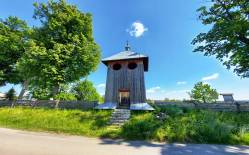Tserkva of St. Nicholas the Wonderworker in Wielkie Oczy, formerly Greek Catholic church, was built in 1925, and following the Operation Vistula in 1947 it was no longer used for religious purposes, instead it was transformed into a storage facility. Today owned by the State Treasury, it is empty and has no furnishings.
The first Uniate church was built in Wielkie Oczy in 1654 by the owner of the village Mojżesz Mohyła. In 1820 it was replaced by a new tserkva, which was remodelled in 1913. In 1915, an assault by German artillery destroyed buildings in the centre of the village including the tserkva and the nearby belfry. Construction of a new church was initiated in 1924. The design was contributed by Jan Sas-Zubrzycki, and the works were supervised by Eustachy Seredyński. A new free-standing bell tower was also built at the time. A single bell, named Symeon, was eventually placed in it. In 1937 the church was reconstructed. After the Ukrainian population was resettled from here during 1945–1947, the building was acquired by the Local Farming Cooperative Samopomoc Chłopska in Lubaczów and was used for storage of food products and electrotechnical equipment. This continued until 1989. During this time the interior furnishings were either stolen or destroyed. The belfry was demolished around 1955.
The church in Wielkie Oczy is one of the few half-timbered tserkvas in Poland. The building with brick and concrete foundations has a rectangular floor plan and is oriented eastward. The floor, roof structures and eaves are made of wood, the outer walls are partly covered with plaster. The tserkva has a single dome with a neo-Renaissance cupola and round windows; the other windows in the building are semi-circular. Inside the walls were painted in blue, yellow and red; the colours have been only partly preserved.
In the village we can also see the main square, church of Immaculate Conception of the Blessed Virgin Mary, an old synagogue, a former Dominican monastery, an old manor house - today a seat of the local authorities, as well as the old cemetery with some crosses made in Brusno.
Photo: Krystian Kłysewicz
Gallery

Recommended venues on the Trail







This website has been modernized with the financial support of the European Union under the Cross-Border Cooperation Programme Poland-Belarus-Ukraine 2014-2020. The responsibility for its content lies solely with the Podkarpackie Regional Tourism Board and cannot, in any case, be treated as a reflection of the position of the European Union, the Managing Authority, or the Joint Technical Secretariat of the Cross-Border Cooperation Programme Poland-Belarus-Ukraine 2014-2020.









